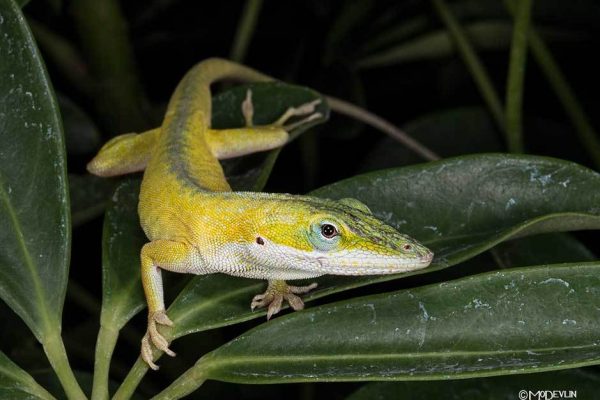Gender:
Some Anoles (A. sagrei) are dimorphic. That is, the female is a different pattern than the male. Cuban Brown Anole females (A. sagrei) have a diamond shaped pattern from the back of their neck to their tail. Males don’t – their pattern is random. Green Anoles (A. carolinensis) of both sexes look the same. Juvenile and mature males have a pair of enlarged postanal scales (just past the vent) that can be seen with slight magnification. Mature males have a hemipenile bulge at the base of the tail. So, if it has either or both, it is a male. Otherwise, it is a female. Dewlaps, white lines, head shape, etc. are not reliably accurate. This is particularly true in immature specimens.
Male Anoles of all species are highly territorial. If you give them enough space to be comfortable, they will try to establish their own territory. They will fight with any other male who appears – sometimes to the death! They will also exhibit an aggression/challenge display to any perceived threat – like a their own reflection in the glass. Only place one male per enclosure unless the enclosure is the size of one of the rooms in your house.
Female Anoles are a bit more sedate. They will have some brief skirmishes and squabbles to establish and maintain a “pecking order” and may even chase each other around in the enclosure but are nowhere near as violent as the males’ encounters.
Color changing:
Green Anoles are mistakenly called “American Chameleons” because of their ability to change colors from brown to green and vice versa. Anoles change color for a variety of reasons not all of which are stress related. The statement “a Green Anole is a happy Anole” is not accurate. The converse is also not true. As long as the Anole is active and eating and drinking, color is not a significant concern. In the almost 45 years I have been keeping them, I have had Anoles that were Green 90% of the time and others that were brown 90% of the time and both lived a long and active life. Most changed color frequently. They do not change color to match their surroundings. They will be darker when they are cold simply because the dark colors absorb heat more efficiently. Almost any color in their palette will blend in with their environment and they will change randomly as they move from one temperature gradient to another or their stress level changes as they travel through the enclosure. The only time a Green Anole will be green for certain is when they are asleep and can’t control their pigmentation.
Color morphs:
Green Anoles appear in several color morphs. There is also a reddish color morph present in Brown Anoles. Green Anoles have three strata of chromatophores (color cells) arranged in layers. The base layer is brown (melanochromatophores), the middle yellow (xanthochromatophores), and the top layer blue (cyanochromatophores). The combination of blue and yellow give the Anole its green color. The absence of yellow produces a blue color morph. The absence of blue produces a yellow morph. The absence of all three would produce an albino. Varying concentrations would produce different shades. Anoles have the ability to turn these layers “off” and “on” and thus, change color.



